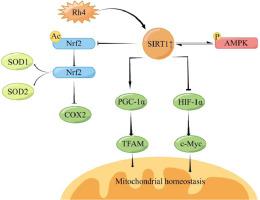Phytomedicine ( IF 6.7 ) Pub Date : 2023-05-29 , DOI: 10.1016/j.phymed.2023.154906 Anni Zhu 1 , Zhiguang Duan 1 , Yanru Chen 2 , Chenhui Zhu 1 , Daidi Fan 1

|
Background
The aging of skeletal muscle is the leading cause of physical disability in older adults, currently effective treatment methods are lacking. Ginsenoside Rh4, an active component extracted from ginseng, possesses beneficial anti-inflammatory and anti-oxidative effects.
Purpose
The aim of this study was to elucidate the antioxidant effect of ginsenoside Rh4 on aging skeletal muscle and its molecular mechanism of anti-aging of skeletal muscle.
Study design
In this study, we employed a D-galactose-induced model of skeletal muscle aging to investigate whether ginsenoside Rh4 can delay the process of skeletal muscle senescence.
Methods
The effects of ginsenoside Rh4 on oxidative damage and inflammation in aging skeletal muscle were analyzed using immunofluorescence, immunohistochemistry, ELISA kits, H&E staining, flow cytometry, and protein immunoblotting. The changes of ginsenoside Rh4 on mitochondrial morphology were observed by transmission electron microscopy, and ELISA kits and protein immunoblotting analyzed the effects of ginsenoside Rh4 on mitochondrial homeostasis in skeletal muscle cells. The influence of ginsenoside Rh4 on the SIRT1 signaling pathway in aging skeletal muscle were investigated by protein immunoblotting, immunofluorescence, and β-galactosidase staining.
Results
Our results showed that Rh4 improved the morphology of muscle fibers and produced an anti-inflammatory response. Furthermore, in vitro experiments indicated that ginsenosides reduced the production of senescent cells, while Rh4 effectively alleviated oxidative damage in skeletal muscle and restored mitochondrial balance. Transcriptome analysis and molecular docking showed that Rh4 improved mitochondrial homeostasis and delayed skeletal muscle aging by regulating the PGC-1α-TFAM and HIF-1α-c-Myc pathways via targeting SIRT1.
Conclusion
Ginsenoside Rh4 improves oxidative stress and inflammation in skeletal muscle by activating SIRT1, deacetylating Nrf2, regulating PGC-1α-TFAM and HIF-1α-c-Myc pathways, and enhancing mitochondrial homeostasis, thus achieving the effect of delaying skeletal muscle aging.
中文翻译:

人参皂苷Rh4通过SIRT1途径延缓骨骼肌衰老
背景
骨骼肌老化是导致老年人身体残疾的主要原因,目前缺乏有效的治疗方法。人参皂苷 Rh4 是从人参中提取的活性成分,具有有益的抗炎和抗氧化作用。
目的
本研究旨在阐明人参皂苷Rh4对衰老骨骼肌的抗氧化作用及其抗骨骼肌衰老的分子机制。
学习规划
在本研究中,我们采用D-半乳糖诱导的骨骼肌衰老模型来研究人参皂苷Rh4是否可以延缓骨骼肌衰老的过程。
方法
采用免疫荧光、免疫组化、ELISA试剂盒、H&E 染色、流式细胞术和蛋白质免疫印迹分析人参皂苷 Rh4 对衰老骨骼肌氧化损伤和炎症的影响。通过透射电镜观察人参皂苷Rh4对线粒体形态的变化,并通过ELISA试剂盒和蛋白免疫印迹分析人参皂苷Rh4对骨骼肌细胞线粒体稳态的影响。通过蛋白质免疫印迹、免疫荧光和β-半乳糖苷酶染色研究人参皂苷Rh4对衰老骨骼肌SIRT1信号通路的影响。
结果
我们的结果表明,Rh4 改善了肌纤维的形态并产生抗炎反应。此外,体外实验表明,人参皂苷减少了衰老细胞的产生,而Rh4则有效减轻骨骼肌的氧化损伤并恢复线粒体平衡。转录组分析和分子对接表明,Rh4 通过靶向 SIRT1 调节 PGC-1α-TFAM 和 HIF-1α-c-Myc 通路,改善线粒体稳态并延缓骨骼肌衰老。
结论
人参皂苷Rh4通过激活SIRT1、去乙酰化Nrf2、调节PGC-1α-TFAM和HIF-1α-c-Myc通路、增强线粒体稳态来改善骨骼肌氧化应激和炎症,从而达到延缓骨骼肌衰老的作用。






























 京公网安备 11010802027423号
京公网安备 11010802027423号